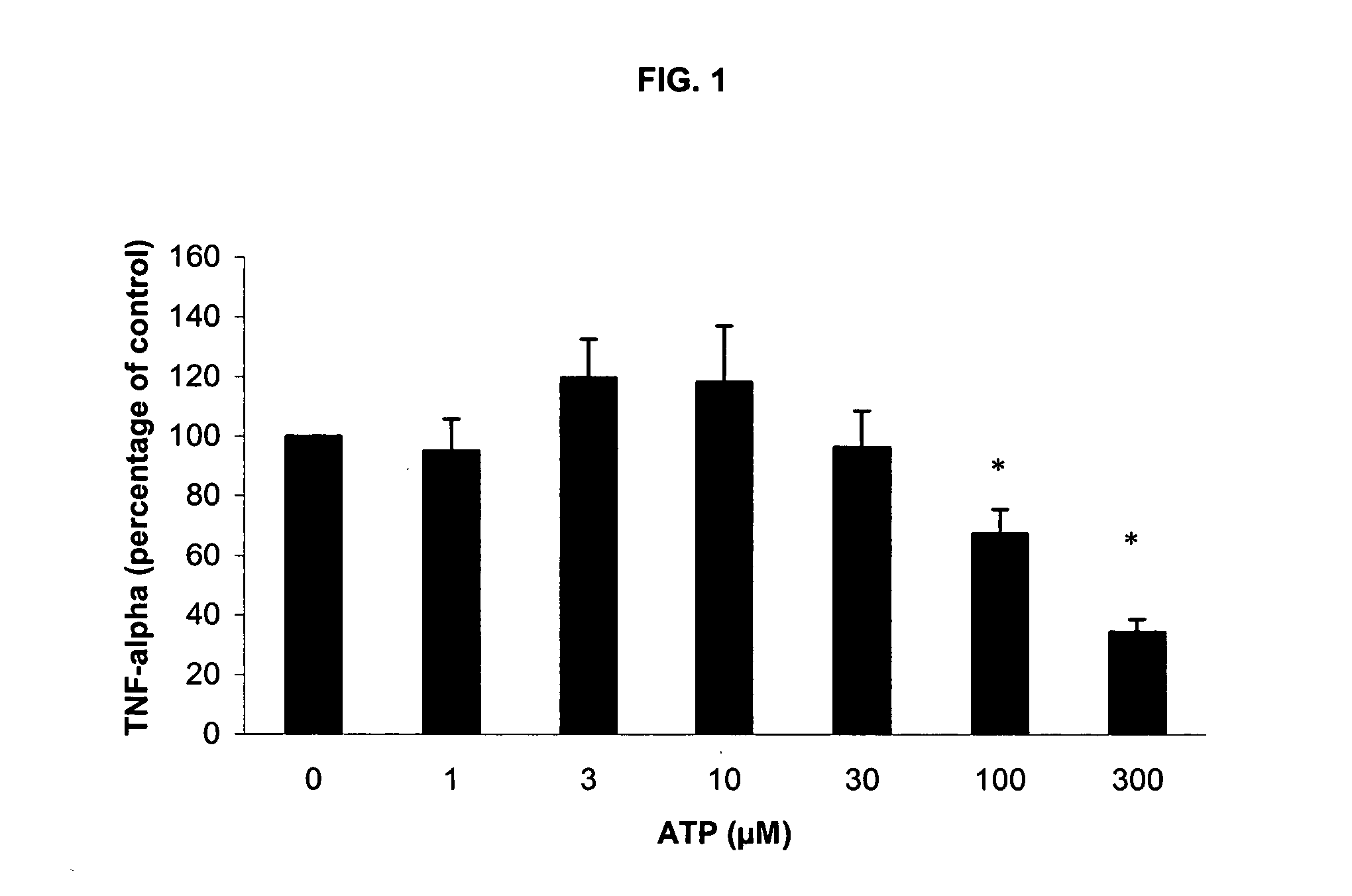Use of ATP for the manufacture of a medicament for treating certain inflammatory conditions, oxidative stress and fatigue
a technology of adenosine 5′triphosphate and a manufacturing process, which is applied in the direction of biocide, drug composition, animal husbandry, etc., can solve the problems of deterioration in the control group, high health care system costs, etc., and achieve the effects of preventing intestinal damage, modulating inflammation, and inhibiting the inflammatory respons
- Summary
- Abstract
- Description
- Claims
- Application Information
AI Technical Summary
Benefits of technology
Problems solved by technology
Method used
Image
Examples
experiment 1
Methods
[0194] For the first experiment, purified phyto-haemagglutinin HA16 (PHA) and E. Coli 0.26: B6 lipopolysaccharide (LPS) were from Murex, Dartford, UK and Sigma Chemical Co, St. Louis, USA, respectively. Human TNF-α (7300 pg / ml) was obtained from CLB / Sanquin, The Netherlands. RPMI 1640 medium containing L-glutamine was obtained from Gibco, UK. Adenosine-5′-triphosphate disodium salt (ATP) was purchased from Calbiochem, USA.
[0195] Blood was collected from 8 healthy subjects in heparin containing vacutainer tubes (Vacutainer, Becton-Dickinson, 170 I.U). Pilot experiments showed that storage time (1-4 h) and temperature (4 and 20° C., respectively) had no effect on LPS / PHA-stimulated TNF-α and the IL-10 release from whole blood. Whole blood was aliquoted into 24-well sterile plates and diluted 1:4 with RPMI 1640 (supplemented with L-glutamine). To induce cytokine production, PHA and bacterial LPS were added at 1 μg / ml and 10 μg / ml final concentration respectively. After adding...
experiment 2
Methods
[0201] Whole blood of 8 healthy subjects was collected as described for Experiment 1, pretreated with 1 or 10 mM H2O2 and ATP at concentrations of 1-300 μM for 30 minutes, and then incubated as in experiment 1 with LPS / PHA for 24 hours.
Results
[0202] Incubation with LPS / PHA under these conditions without ATP induced a strong release of TNF-α, IL-6 and IL-10. As in Experiment 1, addition of ATP induced a dose-dependent reduction in TNF-α production at 100 and 300 μM ATP (FIG. 5). Also, a significant, dose-dependent rise in IL-10 release was observed (FIG. 5). Again, no effect on IL-6 release was detected (FIG. 6).
experiment 3
Methods
[0203] Blood is collected as described for Experiment 1. Whole blood is then aliquoted into 24-well sterile plates and diluted 1:4 with RPMI 1640 (supplemented with L-glutamine). To induce cytokine production, PHA and bacterial LPS are added to whole blood at 1 μg / ml and 10 μg / ml respectively. After addition of ATP and stimulants, the plates are incubated in 5% CO2 at 37° C. for 24 h. Cell-free supernatant fluids are then collected by centrifugation (6000 rpm, 10 min at 4° C.) and stored at −20° C. until tested for presence of cytokines. All incubations are performed in duplicate. ATP, dissolved in RPMI 1640 culture medium, is added to the blood at a final concentration of 1-1000 μM. Blood is pre-incubated with ATP at 5% CO2 at 37° C. for 30 min before stimulation with LPS+PHA. The agonists are added in the same way as ATP, however their stock solutions are prepared in PBS and further diluted in medium.
Results
[0204] Our initial findings indicate that pretreatment of whol...
PUM
| Property | Measurement | Unit |
|---|---|---|
| weight | aaaaa | aaaaa |
| concentrations | aaaaa | aaaaa |
| concentrations | aaaaa | aaaaa |
Abstract
Description
Claims
Application Information
 Login to View More
Login to View More - R&D
- Intellectual Property
- Life Sciences
- Materials
- Tech Scout
- Unparalleled Data Quality
- Higher Quality Content
- 60% Fewer Hallucinations
Browse by: Latest US Patents, China's latest patents, Technical Efficacy Thesaurus, Application Domain, Technology Topic, Popular Technical Reports.
© 2025 PatSnap. All rights reserved.Legal|Privacy policy|Modern Slavery Act Transparency Statement|Sitemap|About US| Contact US: help@patsnap.com



